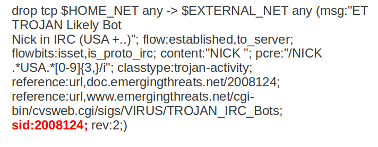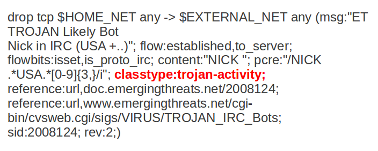This documentation is no longer maintained and exists for historical purposes. The current documentation is located at http://suricata.readthedocs.io/.
Meta-settings¶
Meta-settings have no effect on Suricata's inspection; they have an effect on the way Suricata reports events.
msg (message)¶
The keyword msg gives more information about the signature and the possible alert.
The first part shows the filename of the signature. It is a convention that part is written in uppercase characters.
The format of msg is:
msg: “..........”;
Example:
msg:"ATTACK-RESPONSES 403 Forbidden"; msg:"ET EXPLOIT SMB-DS DCERPC PnP bind attempt";
It is a convention that msg is always the first keyword of a signature.
Another example of msg in a signature:

In this example the red, bold-faced part is the msg.
Sid (signature id)¶
The keyword sid gives every signature its own id. This id is stated with a number.
The format of sid is:
sid:123;
Example of sid in a signature:

In this example the red, bold-faced part is the sid.
Rev (Revision)¶
The sid keyword is almost every time accompanied by rev. Rev represents the version of the signature. If a signature is modified, the number of rev will be incremented by the signature writers.
The format of rev is:
rev:123;
It is a convention that sid comes before rev, and both are the last of all keywords.
Example of rev in a signature:

In this example the red, bold-faced part is the rev.
Gid (group id)¶
The gid keyword can be used to give different groups of signatures another id value (like in sid). Suricata uses by default gid 1. It is possible to modify this. It is not usual that it will be changed, and changing it has no technical implications. You can only notice it in the alert.
Example of gid in a signature:
This is an example from the fast.log.
In the part [1:2008124:2], 1 is the gid (2008124 is the the sid and 2 the rev).
Classtype¶
The classtype keyword gives information about the classification of rules and alerts. It consists of a short name, a long name and a priority. It can tell for example whether a rule is just informational or is about a hack etcetera. For each classtype, the classification.config has a priority which will be used in the rule.
It is a convention that classtype comes before sid and rev and after the rest of the keywords.
Example classtype:
config classification: web-application-attack,Web Application Attack,1
config classification: not-suspicious,Not Suspicious Traffic,3

In this example you see how classtype appears in signatures, the classification.config and the alert.
Another example of classtype in a signature:

In this example the red, bold-faced part is the classtype.
Reference¶
The reference keywords direct to places where information about the signature and about the problem the signature tries to address, can be found. The reference keyword can appear multiple times in a signature.
This keyword is meant for signature-writers and analysts who investigate why a signature has matched. It has the following format:
reference: url, www.info.nl
In this example url is the type of reference. After that comes the actual reference (notice here you can not use http before the url).
There are different types of references:
type:
system URL Prefix
bugtraq http://www.securityfocus.com/bid
cve http://cve.mitre.org/cgi-bin/cvename.cgi?name=
nessus http://cgi.nessus.org/plugins/dump.php3?id=
arachnids (No longer available but you might still encounter this in signatures.)
http://www.whitehats.com/info/IDS
mcafee http://vil.nai.com/vil/dispVirus.asp?virus_k=
url http://
For example bugtraq will be replaced by the full url:
reference: bugtraq, 123; http://www.securityfocus.com/bid
Example of reference in a signature:

In this example the red, bold-faced part is the action.
Priority¶
The priority keyword comes with a mandatory numeric value which can range from 1 till 255. The numbers 1 to 4 are most often used.
Signatures with a higher priority will be examined first. The highest priority is 1.
Normally signatures have already a priority through class type. This can be overruled with the keyword priority.
The format of priority is:
priority:1;
Metadata¶
Suricata ignores the words behind meta data.
Suricata supports this keyword because it is part of the signature language.
The format is:
metadata:......;
locked